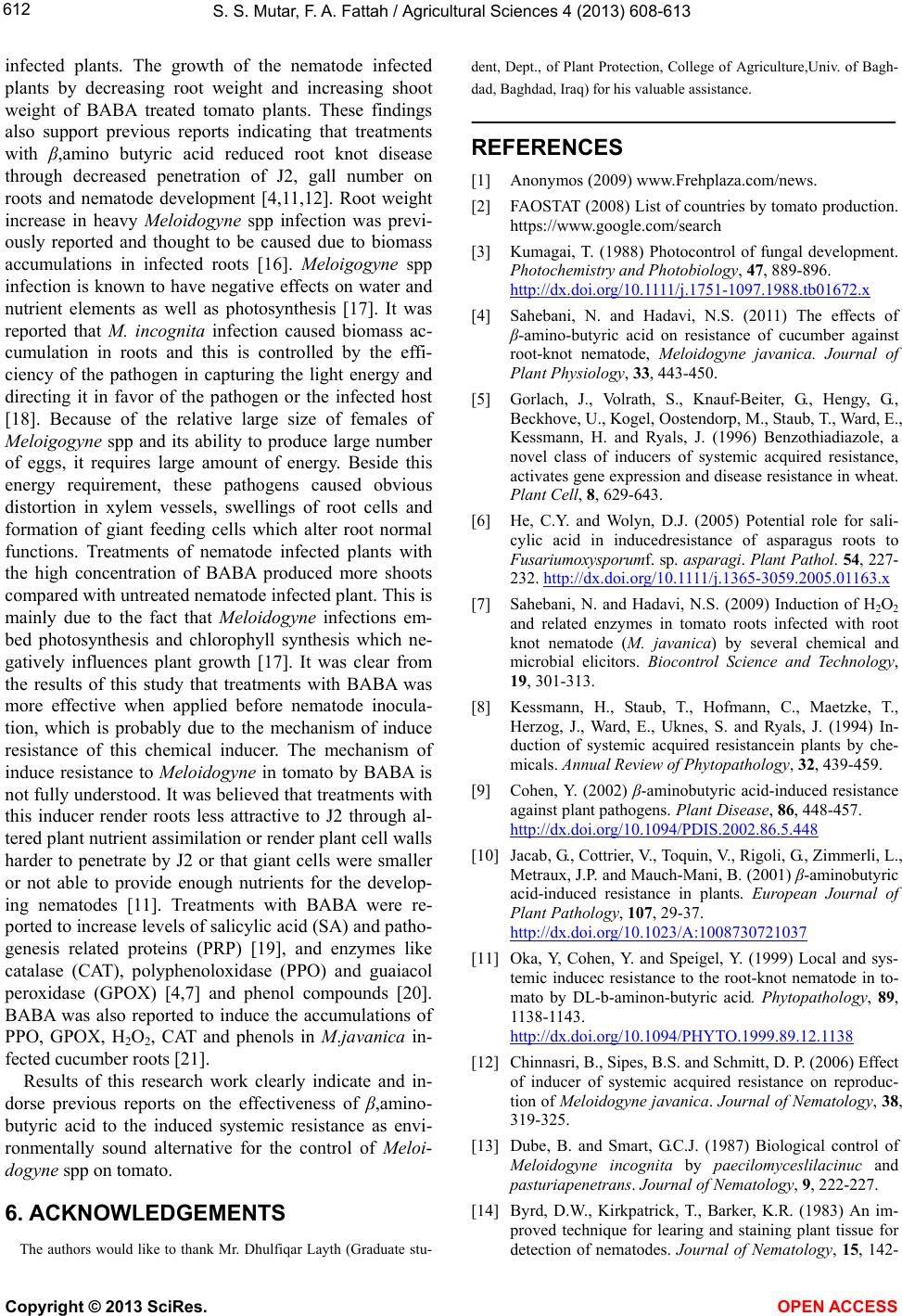
S. S. Mutar, F. A. Fattah / Agricultural Sciences 4 (2013) 608-613
612
infected plants. The growth of the nematode infected
plants by decreasing root weight and increasing shoot
weight of BABA treated tomato plants. These findings
also support previous reports indicating that treatments
with β,amino butyric acid reduced root knot disease
through decreased penetration of J2, gall number on
roots and nematode development [4,11,12]. Root weight
increase in heavy Meloidogyne spp infection was previ-
ously reported and thought to be caused due to biomass
accumulations in infected roots [16]. Meloigogyne spp
infection is known to have negative effects on water and
nutrient elements as well as photosynthesis [17]. It was
reported that M. incognita infection caused biomass ac-
cumulation in roots and this is controlled by the effi-
ciency of the pathogen in capturing the light energy and
directing it in favor of the pathogen or the infected host
[18]. Because of the relative large size of females of
Meloigogyne spp and its ability to produce large number
of eggs, it requires large amount of energy. Beside this
energy requirement, these pathogens caused obvious
distortion in xylem vessels, swellings of root cells and
formation of giant feeding cells which alter root normal
functions. Treatments of nematode infected plants with
the high concentration of BABA produced more shoots
compared with untreated nematode infected plant. This is
mainly due to the fact that Meloidogyne infections em-
bed photosynthesis and chlorophyll synthesis which ne-
gatively influences plant growth [17]. It was clear from
the results of this study that treatments with BABA was
more effective when applied before nematode inocula-
tion, which is probably due to the mechanism of induce
resistance of this chemical inducer. The mechanism of
induce resistance to Meloidogyne in tomato by BABA is
not fully understood. It was believed that treatments with
this inducer render roots less attractive to J2 through al-
tered plant nutrient assimilation or render plant cell walls
harder to penetrate by J2 or that giant cells were smaller
or not able to provide enough nutrients for the develop-
ing nematodes [11]. Treatments with BABA were re-
ported to increase levels of salicylic acid (SA) and patho-
genesis related proteins (PRP) [19], and enzymes like
catalase (CAT), polyphenoloxidase (PPO) and guaiacol
peroxidase (GPOX) [4,7] and phenol compounds [20].
BABA was also reported to induce the accumulations of
PPO, GPOX, H2O2, CAT and phenols in M.javanica in-
fected cucumber roots [21].
Results of this research work clearly indicate and in-
dorse previous reports on the effectiveness of β,amino-
butyric acid to the induced systemic resistance as envi-
ronmentally sound alternative for the control of Meloi-
dogyne sp p on t omato.
6. ACKNOWLEDGEMENTS
The authors would like to thank Mr. Dhulfiqar Layth (Graduate stu-
dent, Dept., of Plant Protection, College of Agriculture,Univ. of Bagh-
dad, Baghdad, Iraq) for his valuable assistance.
REFERENCES
[1] Anonymos (2009) www.Frehplaza.com/news.
[2] FAOSTAT (2008) List of countries by tomato production.
https://www.google.com/search
[3] Kumagai, T. (1988) Photocontrol of fungal development.
Photochemistry and Photobiology, 47, 889-896.
http://dx.doi.org/10.1111/j.1751-1097.1988.tb01672.x
[4] Sahebani, N. and Hadavi, N.S. (2011) The effects of
β-amino-butyric acid on resistance of cucumber against
root-knot nematode, Meloidogyne javanica. Journal of
Plant Physiology, 33, 443-450.
[5] Gorlach, J., Volrath, S., Knauf-Beiter, G., Hengy, G.,
Beckhove, U., Kogel, Oostendorp, M., Staub, T., Ward, E.,
Kessmann, H. and Ryals, J. (1996) Benzothiadiazole, a
novel class of inducers of systemic acquired resistance,
activates gene expression and disease resistance in wheat.
Plant Cell, 8, 629-643.
[6] He, C.Y. and Wolyn, D.J. (2005) Potential role for sali-
cylic acid in inducedresistance of asparagus roots to
Fusariumoxysporumf. sp. asparagi. Plant Pathol. 54, 227-
232. http://dx.doi.org/10.1111/j.1365-3059.2005.01163.x
[7] Sahebani, N. and Hadavi, N.S. (2009) Induction of H2O2
and related enzymes in tomato roots infected with root
knot nematode (M. javanica) by several chemical and
microbial elicitors. Biocontrol Science and Technology,
19, 301-313.
[8] Kessmann, H., Staub, T., Hofmann, C., Maetzke, T.,
Herzog, J., Ward, E., Uknes, S. and Ryals, J. (1994) In-
duction of systemic acquired resistancein plants by che-
micals. Annual Review of Phytopathology, 32, 439-459.
[9] Cohen, Y. (2002) β-aminobutyric acid-induced resistance
against plant pathogens. Plant Disease, 86, 448-457.
http://dx.doi.org/10.1094/PDIS.2002.86.5.448
[10] Jacab, G., Cottrier, V., Toquin, V., Rigoli, G., Zimmerli, L.,
Metraux, J.P. and Mauch-Mani, B. (2001) β-aminobutyric
acid-induced resistance in plants. European Journal of
Plant Pathology, 107, 29-37.
http://dx.doi.org/10.1023/A:1008730721037
[11] Oka, Y, Cohen, Y. and Speigel, Y. (1999) Local and sys-
temic inducec resistance to the root-knot nematode in to-
mato by DL-b-aminon-butyric acid. Phytopathology, 89,
1138-1143.
http://dx.doi.org/10.1094/PHYTO.1999.89.12.1138
[12] Chinnasri, B., Sipes, B.S. and Schmitt, D. P. (2006) Effect
of inducer of systemic acquired resistance on reproduc-
tion of Meloidogyne javanica. Journal of Nematology, 38,
319-325.
[13] Dube, B. and Smart, G.C.J. (1987) Biological control of
Meloidogyne incognita by paecilomyceslilacinuc and
pasturiapenetrans. Journal of Nematology, 9, 222-227.
[14] Byrd, D.W., Kirkpatrick, T., Barker, K.R. (1983) An im-
proved technique for learing and staining plant tissue for
detection of nematodes. Journal of Nematology, 15, 142-
Copyright © 2013 SciRes. OPEN ACCESS